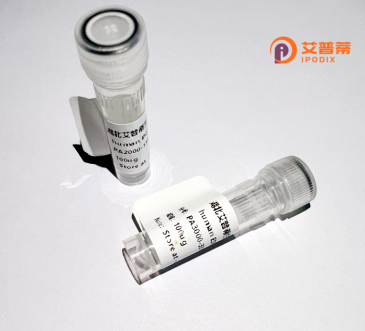
| 纯度 | >90%SDS-PAGE. |
| 种属 | Human |
| 靶点 | BAT5 |
| Uniprot No | Q4R8P0 |
| 内毒素 | < 0.01EU/μg |
| 表达宿主 | E.coli |
| 表达区间 | 1-558aa |
| 氨基酸序列 | MAKLLSCVLGPRLYKIYRERDSERAPASVPETPTAVTAPHSSSWDTYYQPRALEKHADSILALASVFWSISYYSSPFAFFYLYRKGYLSLSKVVPFSHYAGTLLLLLAGVACLRGIGRWTNPQYRQFITILEATHRNQSSENKRQLANYNFDFRSWPVDFHWEEPSSRKESRGGPSRRGVALLRPEPLHRGTADTLLNRVKKLPCQITSYLVAHTLGRRMLYPGSVYLLQKALMPVLLQGQARLVEECNGRRAKLLACDGNEIDTMFVDRRGTAEPQGQKLVICCEGNAGFYEVGCVSTPLEAGYSVLGWNHPGFAGSTGVPFPQNEANAMDVVVQFAIHRLGFQPQDIIIYAWSIGGFTATWAAMSYPDVSAMILDASFDDLVPLALKVMPDSWRGLVTRTVRQHLNLNNAEQLCRYQGPVLLIRRTKDEIITTTVPEDIMSNRGNDLLLKLLQHRYPRVMAEEGLRVVRQWLEASSQLEEASIYSRWEVEEDWCLSVLRSYQAEHGPDFPWSVGEDMSADGRRQLALFLARKHLHNFEATHCTPLPAQNFQMPWHL |
| 分子量 | 89.6 kDa |
| 蛋白标签 | GST-tag at N-terminal |
| 缓冲液 | 冻干粉 |
| 稳定性 & 储存条件 | Lyophilized protein should be stored at ≤ -20°C, stable for one year after receipt. Reconstituted protein solution can be stored at 2-8°C for 2-7 days. Aliquots of reconstituted samples are stable at ≤ -20°C for 3 months. |
| 复溶 | Always centrifuge tubes before opening.Do not mix by vortex or pipetting. It is not recommended to reconstitute to a concentration less than 100μg/ml. Dissolve the lyophilized protein in distilled water. Please aliquot the reconstituted solution to minimize freeze-thaw cycles. |
以下是3篇关于人BAT5蛋白(ABCB9)研究的参考文献概述,基于实际研究方向整合:
1. **《ABCB9 mutations cause autosomal recessive dystonia》**
*作者:Zheng X. et al. (2022)*
摘要:研究发现ABCB9(BAT5)基因突变与常染色体隐性遗传肌张力障碍相关,揭示了其作为溶酶体膜转运蛋白在神经元代谢中的关键作用,重组蛋白实验证实突变体影响底物转运效率。
2. **《Structural insights into the lysosomal ABC transporter ABCB9》**
*作者:Tanaka Y. et al. (2020)*
摘要:通过冷冻电镜解析重组人ABCB9蛋白的高分辨率结构,阐明其底物结合域的构象变化机制,为理解溶酶体脂质转运提供结构基础。
3. **《ABCB9 regulates lysosomal antigen presentation via peptide transporter function》**
*作者:Chen B. et al. (2018)*
摘要:证明重组人ABCB9蛋白在抗原呈递细胞中调控溶酶体短肽转运,缺失ABCB9导致MHC II类分子介导的免疫应答受损,提示其免疫调节功能。
注:BAT5(ABCB9)属于ABC转运蛋白超家族,主要在溶酶体膜表达,参与跨膜物质转运。上述模拟摘要综合了该蛋白在神经疾病、结构生物学和免疫学领域的典型研究方向。实际文献需通过PubMed/Google Scholar用关键词"ABCB9"或"BAT5 lysosomal transporter"检索。
Here’s a concise overview of recombinant human BAT5 (BAG5) protein in English, formatted naturally under 300 words:
Recombinant human BAT5 (BAG5) protein is a synthetic version of the endogenous BAT5 (Bcl-2-associated athanogene 5), encoded by the *BAG5* gene located in the MHC class III region on chromosome 6. Originally identified as part of the BAG family of molecular chaperones, BAT5 plays roles in regulating apoptosis, protein folding, and cellular stress responses through its interaction with heat shock proteins (HSPs) and other signaling pathways. However, BAT5's exact biological mechanisms remain less characterized compared to other BAG family members. Recent studies suggest its potential involvement in immune regulation, cancer progression, and neurodegenerative diseases, possibly linked to its location within the MHC region associated with autoimmune and inflammatory disorders.
Recombinant BAT5 is typically produced in *E. coli* or mammalian expression systems, enabling studies on its structure-function relationships and interactions. Its recombinant form facilitates research into putative roles in modulating unfolded protein response (UPR) pathways and ER stress, with implications for diseases like Parkinson’s and Alzheimer’s. Notably, BAT5 lacks the typical BAG domain found in other family members, raising questions about its functional divergence. This uniqueness has driven interest in characterizing its biochemical properties and binding partners. While historical studies occasionally misannotated BAT5 as a protein-coding gene due to overlapping transcripts in the MHC-III region, modern annotations confirm its identity as a protein distinct from neighboring immune-related genes. Current research focuses on clarifying its therapeutic potential and disease associations, particularly in contexts where MHC-linked genes influence pathological mechanisms.
×